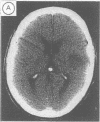Abstract
Somaesthetic temporal discrimination (STD) is the ability to perceive as separate two successive somaesthetic stimuli applied to the same or different parts of the body. Paired electrical stimuli were applied to the index finger, using different time-intervals, to study the STD threshold (STDT) in 84 normal subjects and 51 patients with focal cerebral lesions. Abnormal STDT values were found on the affected side of patients with a lesion of the primary somatosensory cortex, and internal capsulethalamus. Lesions which did not produce sensory impairment but caused abnormal STDT were located in the posterior parietal cortex, the head of the caudate nucleus, the putamen, the medial thalamus and the lenticular nucleus. Frontal, temporal and occipital cortex lesions did not produce any abnormality in the STDT, but one patient with a bilateral lesion of the supplementary motor area (SMA) had abnormal STDT. These results indicate that normal perception of two somaesthetic stimuli as separate in time depends not only upon the integrity of the somatosensory pathway and primary somaesthetic cortex, but also of the posterior parietal cortex, SMA and subcortical structures such as the striatum and thalamus.
Full text
PDF




Images in this article
Selected References
These references are in PubMed. This may not be the complete list of references from this article.
- Albert M. L., Bear D. Time to understand. A case study of word deafness with reference to the role of time in auditory comprehension. Brain. 1974 Jun;97(2):373–384. doi: 10.1093/brain/97.1.373. [DOI] [PubMed] [Google Scholar]
- Alexander G. E., DeLong M. R., Strick P. L. Parallel organization of functionally segregated circuits linking basal ganglia and cortex. Annu Rev Neurosci. 1986;9:357–381. doi: 10.1146/annurev.ne.09.030186.002041. [DOI] [PubMed] [Google Scholar]
- Axelrod S., Thompson L. W., Cohen L. D. Effects of senescence on the temporal resolution of somesthetic stimuli presented to one hand or both. J Gerontol. 1968 Apr;23(2):191–195. doi: 10.1093/geronj/23.2.191. [DOI] [PubMed] [Google Scholar]
- Fucci D., Petrosino L. Cutaneous temporal resolution values for "sophisticated" and "naive" subjects. Percept Mot Skills. 1984 Jun;58(3):831–834. doi: 10.2466/pms.1984.58.3.831. [DOI] [PubMed] [Google Scholar]
- Fuster J. M., Bauer R. H., Jervey J. P. Cellular discharge in the dorsolateral prefrontal cortex of the monkey in cognitive tasks. Exp Neurol. 1982 Sep;77(3):679–694. doi: 10.1016/0014-4886(82)90238-2. [DOI] [PubMed] [Google Scholar]
- GREEN J. B., REESE C. L., PEGUES J. J., ELLIOTT F. A. Ability to distinguish two cutaneous stimuli separated by a brief time interval. Neurology. 1961 Nov;11:1006–1010. doi: 10.1212/wnl.11.11.1006. [DOI] [PubMed] [Google Scholar]
- Galvin R. J., Regan D., Heron J. R. Impaired temporal resolution of vision after acute retrobulbar neuritis. Brain. 1976 Jun;99(2):255–268. doi: 10.1093/brain/99.2.255. [DOI] [PubMed] [Google Scholar]
- Heilman K. M., Van Den Abell T. Right hemisphere dominance for attention: the mechanism underlying hemispheric asymmetries of inattention (neglect). Neurology. 1980 Mar;30(3):327–330. doi: 10.1212/wnl.30.3.327. [DOI] [PubMed] [Google Scholar]
- Ivry R. B., Keele S. W., Diener H. C. Dissociation of the lateral and medial cerebellum in movement timing and movement execution. Exp Brain Res. 1988;73(1):167–180. doi: 10.1007/BF00279670. [DOI] [PubMed] [Google Scholar]
- Jürgens U. The efferent and afferent connections of the supplementary motor area. Brain Res. 1984 May 21;300(1):63–81. doi: 10.1016/0006-8993(84)91341-6. [DOI] [PubMed] [Google Scholar]
- Lackner J. R., Teuber H. L. Alterations in auditory fusion thresholds after cerebral injury in man. Neuropsychologia. 1973 Oct;11(4):409–415. doi: 10.1016/0028-3932(73)90027-4. [DOI] [PubMed] [Google Scholar]
- Ng A., Burke D., Al-Shehab A. Hyperexcitability of cutaneous afferents during the supernormal period. Relevance to paraesthesiae. Brain. 1987 Aug;110(Pt 4):1015–1031. doi: 10.1093/brain/110.4.1015. [DOI] [PubMed] [Google Scholar]
- Plant G. T., Hess R. F. Temporal frequency discrimination in optic neuritis and multiple sclerosis. Brain. 1985 Sep;108(Pt 3):647–676. doi: 10.1093/brain/108.3.647. [DOI] [PubMed] [Google Scholar]
- Riklan M., Levita E., Misiak H. Critical flicker frequency and integrative functions in parkinsonism. J Psychol. 1970 May;75(2D):45–51. doi: 10.1080/00223980.1970.9916804. [DOI] [PubMed] [Google Scholar]
- Roland P. E. Somatotopical tuning of postcentral gyrus during focal attention in man. A regional cerebral blood flow study. J Neurophysiol. 1981 Oct;46(4):744–754. doi: 10.1152/jn.1981.46.4.744. [DOI] [PubMed] [Google Scholar]
- SHAGASS C., SCHWARTZ M. RECOVERY FUNCTIONS OF SOMATOSENSORY PERIPHERAL NERVE AND CEREBRAL EVOKED RESPONSES IN MAN. Electroencephalogr Clin Neurophysiol. 1964 Aug;17:126–135. doi: 10.1016/0013-4694(64)90144-0. [DOI] [PubMed] [Google Scholar]
- Tanaka Y., Yamadori A., Mori E. Pure word deafness following bilateral lesions. A psychophysical analysis. Brain. 1987 Apr;110(Pt 2):381–403. doi: 10.1093/brain/110.2.381. [DOI] [PubMed] [Google Scholar]
- Weintraub S., Mesulam M. M. Right cerebral dominance in spatial attention. Further evidence based on ipsilateral neglect. Arch Neurol. 1987 Jun;44(6):621–625. doi: 10.1001/archneur.1987.00520180043014. [DOI] [PubMed] [Google Scholar]






